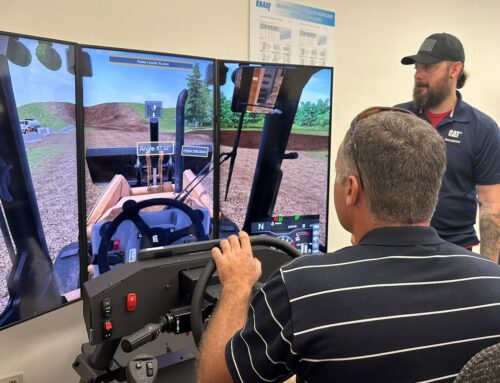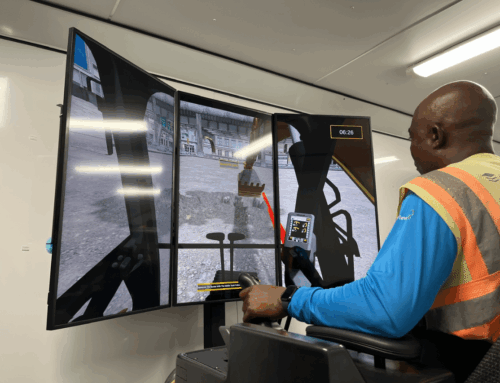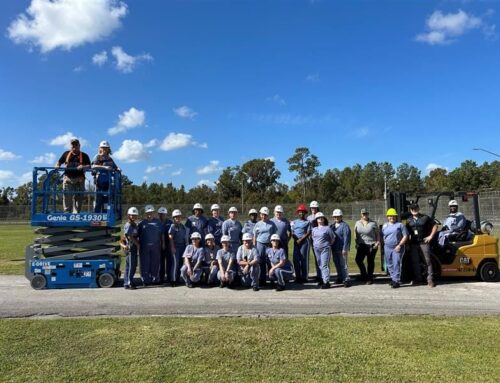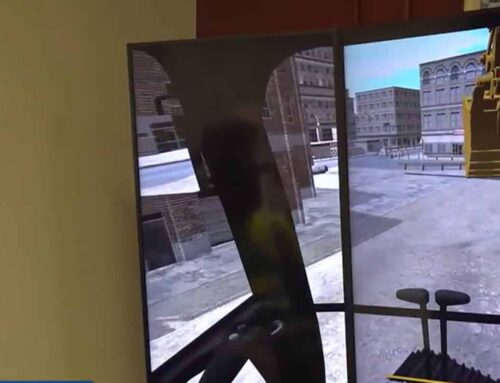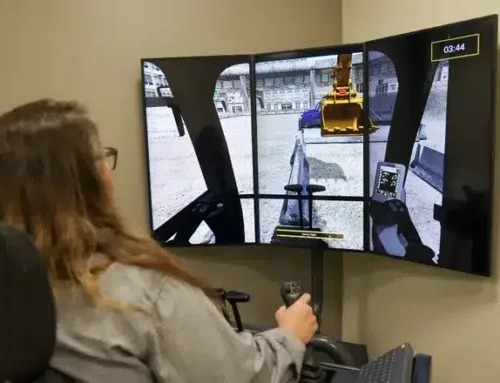Nevada, one of the fastest growing states in the USA, needs a workforce skilled enough to keep up with the rising construction industry demands. Nevada Department of Corrections (NDOC) is taking big steps to strengthen the workforce in support of this effort. One way they do that is through the use of vocational equipment designed to train and certify inmates as heavy equipment operators.
The Nevada Dept. of Corrections trains offenders using Cat® Simulators. Offenders gain real skills, which give them a chance at a life outside prison, and helps to strengthen the state’s workforce.

Simulators Build Skills, Save Money
In April 2017, Clark County School District (who oversees the adult education program at the facility) purchased four Cat® Simulators from Simformotion™ LLC for placement at High Desert State Prison (HDSP) located approximately 30 miles north of Las Vegas. High Desert boasts a capacity of just under 4,200 inmates and is the largest prison in the Nevada criminal justice system. Placing simulators here, rather than in another of the seven institutions in the state maximizes access to the largest population of inmates, the majority of whom will be released in the Las Vegas/Henderson area. Building an apprenticeship readiness program here is a good fit because while Nevada populations are booming all over the state, southern Nevada remains the largest and most likely area for a person to find employment in construction. Using simulators gives the inmates the ability to learn to handle those Caterpillar machines that are commonly used for construction such as Dozers, Small Wheel Loaders, Hydraulic Excavators and Motor Graders. Inmates learn while sitting in a classroom, the perfect situation when one is in custody.
“This is an inexpensive way to give inmates real life skills making them more marketable when they return to the community,” stated NDOC Director James Dzurenda. “Few teaching tools fit our needs as well as these simulators do. It would be impossible for our department to teach inmates these skills otherwise.”
This type of simulation program saves businesses money that used to be spent to repair the real machines when a trainee made a mistake. Construction companies have reported fewer costly mistakes made by people who had initial training on the simulators.
“They can make the mistakes in a virtual world so by the time they get out to the job site, they know what they are doing,” stated Michael Budd, an employee of the Clark County School District who trains the inmates on the simulators. “These simulators are very realistic. They bounce and bump much like the real deal. It’s a great way to learn in a safe environment.”
Waiting List of Inmates For the Program
The simulators themselves may look like something one might see in an arcade, with a realistic seat, monitor and controls. That is where the similarities end. The software is a serious training tool. It teaches the trainee the same applications as operators use on jobsites around the world. The Clark County School District provided the simulators to the prison, which can easily fill the seats. Inmates are anxious to try their hand at the simulators but there are a few pre-requisites before they get to participate in the program. Each inmate must have a high school diploma or equivalency and must have the demeanor and attitude to be hirable.
“Inmates need to show us that they take their future seriously to be part of this program. They must be willing to use the skills they learn in the real world,” added Dzurenda. “Because the inmates can earn certifications to begin training on the full-size heavy equipment once they are released, this program can jump start their careers right out of prison.” The heavy equipment simulator program sports a waiting list of about a year-and-a-half.
Simformotion has provided heavy equipment simulators to organizations worldwide delivering an authentic experience for people who otherwise couldn’t train on the real thing. While the company supplies simulators to businesses and schools, their products are uniquely fitting to a prison setting where safety and security are paramount. Over the past 10 years, Simformotion has been building virtual reality simulation trainers for key organizations including the U.S. military, Department of Justice and construction and mining companies worldwide.

Employment, or Lack of It, Plays a Big Factor
According to the Bureau of Justice Statistics, a study completed in 2005 found within 5 years of release, 76.6% of released prisoners were rearrested. That’s a recidivism rate of over three-quarters, and of those prisoners, more than half (56.7%) were arrested by the end of the first year. Once released, former inmates are competing for jobs with those individuals who’ve never served time behind bars, and that makes it an uneven playing field. Former inmates often can’t find a job out of prison and feel there are no other options but to return to what they know. If they can gain a marketable skill in prison, it significantly opens up possibilities for them besides a life of crime. Being released into the community with a certificate assuring potential employers that this individual has passed the preliminary classes to handle heavy equipment doesn’t mean they are ready to work in the field, but it does mean they have more experience than the average person, and they need only take the next level of classes to be employable. It gives any potential employer the understanding that this person worked during their sentence; they were motivated to learn and achieve. The certificate also gives the inmate a sense of accomplishment and boosts their self-confidence—qualities necessary to successfully land a job.
In the first year, 62 inmates have completed the apprenticeship readiness program with the simulators. Unfortunately, there is no mechanism in place to collect data on their success once an inmate is released, but staff members know the program works.
“I know of at least 10 inmates who have gone on to work construction after this program,” stated Michael Budd. “We hear about certain inmates who have been successful. I believe this program makes a big difference in the success rates of the inmates when released. Construction is a great career for these guys to get into. I’m excited to have the opportunity to help someone build the skills to make a better life for themselves once they get out. ”
The program takes one year to complete all four certifications covering Dozers, Small Wheel Loaders, Hydraulic Excavators and Motor Graders. The trainers also make sure the inmates are prepared to pass the union testing necessary to move forward with their careers. In Nevada, prisoners have the opportunity to complete Apprenticeship Readiness Programs and Multi-Craft Core Curriculum sponsored through North America’s Building Trade Unions (NABTU).
“Getting these individuals trained and working is the key to less victimization in our communities,” added Director Dzurenda. “Building stronger and safer neighborhoods is the real business of corrections. It’s our responsibility to offer options and motivation for the inmates to learn and improve. What they do with that lesson once they are back home is up to them.”
By: Brooke Santina
A former deputy sheriff now working in Corrections, Brooke Santina has many colorful career stories she shares in her speaking engagements and writings. Her first novel, Dishrags to Dirtbags, made local acclaim when it was included in the list of best 150 books in Nevada’s first 150 years.


